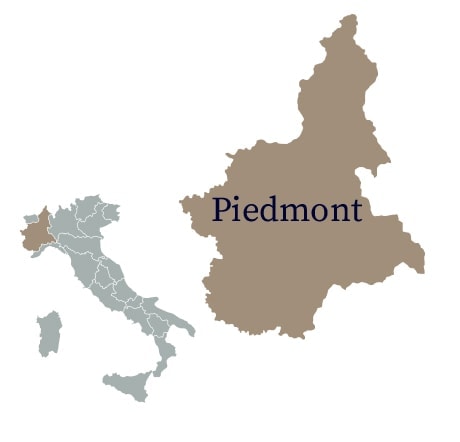
Piedmont Cuisine
Tucked away in the northwestern corner of Italy, gastronomically rich Piedmont has long been filled with farmers who’ve provided the region with a bounty of produce and livestock. More than just meat and veggies, it’s a land of wine, pasta, rice, and sweets upon endlessly delicious sweets.
Pork, in particular, has played an important part in the region’s culinary traditions, serving as the centerpiece of feast days, during which all parts of the swine would be used. From the blood to the feet, pork has been included in the creation of pies, lasagnas, and favorite local plates such as the peasant dish batsoa. These feast days haven’t all just been about the pig, either, but also the decanting of wine, often celebrated by eating zuppa bati il gran, a beef broth soup with tomatoes and chicken livers.
As for pasta, egg-based versions — such as the noodle-style tajarin — are Piedmont’s pride and joy. Meanwhile, the local diet is also very much anchored by the locally grown rice. Rice of all kinds, in fact, as the region is the birthplace of countless dishes that feature the grain as star. We’re talking paniscia — the gastronomic symbol of the Novara province — which consists of vegetables, bacon, beans, sausage, pork liver and wine, all mixed up with rice. And then in the region of Vercelli, the rice has traditionally been combined with beans, and even frogs caught in the rice fields — or, alternatively, it can also be served with Gorgonzola and slugs (how’s that for creativity?). Though these rice dishes surely sound enticing, you’ll find that we’ve included a slightly easier-to-execute rice recipe, risotto ai funghi porcini.
Piedmont is arguably one of the most famous wine-producing regions in the world. Putting it on the global map is its beloved Nebbiolo, the grape behind favorites such as Barolo, a robust red often served with game and roasts, and Barbaresco, the preferred pairing for dishes with more subtle flavors. Other grapes and wines flourish here, too, from the Barbera and Dolcetto varietals to the Cortese del Monferrato white wines, and the passito-style sweet wines. And then, of course, there’s the semi-sweet sparkling wine, or spumante, called Moscato d’Asti, which is produced in the countryside of Asti.

Piedmont Cuisine
Tucked away in the northwestern corner of Italy, gastronomically rich Piedmont has long been filled with farmers who’ve provided the region with a bounty of produce and livestock. More than just meat and veggies, it’s a land of wine, pasta, rice, and sweets upon endlessly delicious sweets.
Pork, in particular, has played an important part in the region’s culinary traditions, serving as the centerpiece of feast days, during which all parts of the swine would be used. From the blood to the feet, pork has been included in the creation of pies, lasagnas, and favorite local plates such as the peasant dish batsoa. These feast days haven’t all just been about the pig, either, but also the decanting of wine, often celebrated by eating zuppa bati il gran, a beef broth soup with tomatoes and chicken livers.
As for pasta, egg-based versions — such as the noodle-style tajarin — are Piedmont’s pride and joy. Meanwhile, the local diet is also very much anchored by the locally grown rice. Rice of all kinds, in fact, as the region is the birthplace of countless dishes that feature the grain as star. We’re talking paniscia — the gastronomic symbol of the Novara province — which consists of vegetables, bacon, beans, sausage, pork liver and wine, all mixed up with rice. And then in the region of Vercelli, the rice has traditionally been combined with beans, and even frogs caught in the rice fields — or, alternatively, it can also be served with Gorgonzola and slugs (how’s that for creativity?). Though these rice dishes surely sound enticing, you’ll find that we’ve included a slightly easier-to-execute rice recipe, risotto ai funghi porcini.
Piedmont is arguably one of the most famous wine-producing regions in the world. Putting it on the global map is its beloved Nebbiolo, the grape behind favorites such as Barolo, a robust red often served with game and roasts, and Barbaresco, the preferred pairing for dishes with more subtle flavors. Other grapes and wines flourish here, too, from the Barbera and Dolcetto varietals to the Cortese del Monferrato white wines, and the passito-style sweet wines. And then, of course, there’s the semi-sweet sparkling wine, or spumante, called Moscato d’Asti, which is produced in the countryside of Asti.